Introduction:
Metal casting is a widely used manufacturing process for producing complex and intricate metal parts. It involves pouring molten metal into a mold and allowing it to solidify. However, traditional casting methods often result in defects such as porosity, shrinkage, and poor mechanical properties. To overcome these challenges, engineers and researchers have developed various advanced casting techniques, one of which is squeeze casting. This article aims to explore the concept of squeeze casting and its benefits in enhancing metal casting processes.
What is Squeeze Casting?
Squeeze casting, also known as liquid forging or liquid metal forging, is a hybrid process that combines elements of casting and forging. It involves applying a controlled amount of pressure to the solidifying metal in the mold cavity. The pressure helps in reducing porosity, enhancing mechanical properties, and improving the overall quality of the cast part.
Process of Squeeze Casting:
The squeeze casting process involves several steps, including mold preparation, metal melting, mold filling, solidification, and applying pressure. Here is a breakdown of each step:
1. Mold Preparation: The mold is prepared by coating it with a refractory material to prevent the molten metal from adhering to it. The mold is then preheated to a suitable temperature.
2. Metal Melting: The metal alloy is melted in a furnace, typically using electric induction or gas-fired methods. The molten metal is then transferred to a ladle ready for casting.
3. Mold Filling: The molten metal is poured into the preheated mold cavity. Gravity or low-pressure methods are commonly used for mold filling to ensure a smooth flow of the molten metal.
4. Solidification: As the molten metal cools, it begins to solidify, taking the shape of the mold cavity. Solidification time depends on the metal alloy being cast.
5. Applying Pressure: Once the solidification process is initiated, a controlled amount of pressure is applied to the solidifying metal using a hydraulic press or mechanical device. The pressure helps in reducing porosity and improving the material’s mechanical properties.
Benefits of Squeeze Casting:
Squeeze casting offers several advantages compared to traditional casting methods. Some of the key benefits include:
1. Reduced Porosity: The application of pressure during solidification helps in eliminating or reducing porosity in the cast part. This results in improved density and mechanical properties of the final product.
2. Enhanced Mechanical Properties: The controlled pressure applied during squeeze casting leads to a refined grain structure, increased strength, and improved fatigue resistance of the cast part. These properties make squeeze-cast components suitable for demanding applications.
3. Complex Geometries: Squeeze casting allows for the production of intricate and complex-shaped parts that cannot be easily achieved using traditional casting methods. The pressure assists in achieving better filling of thin-walled sections and intricate details in the mold cavity.
4. Cost Savings: Squeeze casting can help in reducing material wastage and machining requirements. The improved mechanical properties of the cast parts also reduce the need for secondary operations, resulting in cost savings.
Applications of Squeeze Casting:
Squeeze casting is widely used in various industries where high-strength and high-integrity components are required. Some of the common applications include:
1. Automotive Industry: Squeeze-cast components find extensive use in automotive applications such as engine blocks, pistons, and transmission housings. The enhanced mechanical properties and reduced weight of squeeze-cast parts contribute to improved vehicle performance and fuel efficiency.
2. Aerospace Industry: The aerospace industry benefits from squeeze casting for producing critical components like turbine blades, aerospace alloys, and structural members. The improved integrity and mechanical properties ensure safe and reliable operation in demanding aerospace environments.
3. Defense Applications: Squeeze casting is utilized in the defense sector for manufacturing high-strength and lightweight components for military vehicles, missile systems, and armaments.
Conclusion:
Squeeze casting is an advanced metal casting process that offers numerous advantages over traditional casting methods. The application of controlled pressure during solidification helps in reducing porosity, enhancing mechanical properties, and producing complex parts with improved integrity. With its wide range of applications in automotive, aerospace, and defense industries, squeeze casting continues to play a significant role in advancing the field of metal casting.
-

- Magnesium alloy thixomolding components
-

- OEM high pressure die casting magnesium alloy frame for bicycle
-

- Magensium mountain bike frame
-

- Magnesium alloy die-casting auto parts center control cover
-

- Bicycles for Children Kids Bikes for 3-16 years old Child /OEM Baby Children Cycle Kids Mountain Bicycles 2022
-

- Magnesium alloy Thixomolding power batter housing

 0086-750-5616188
0086-750-5616188 +86 13392089688
+86 13392089688 sales@zhongmei-tech.com
sales@zhongmei-tech.com








